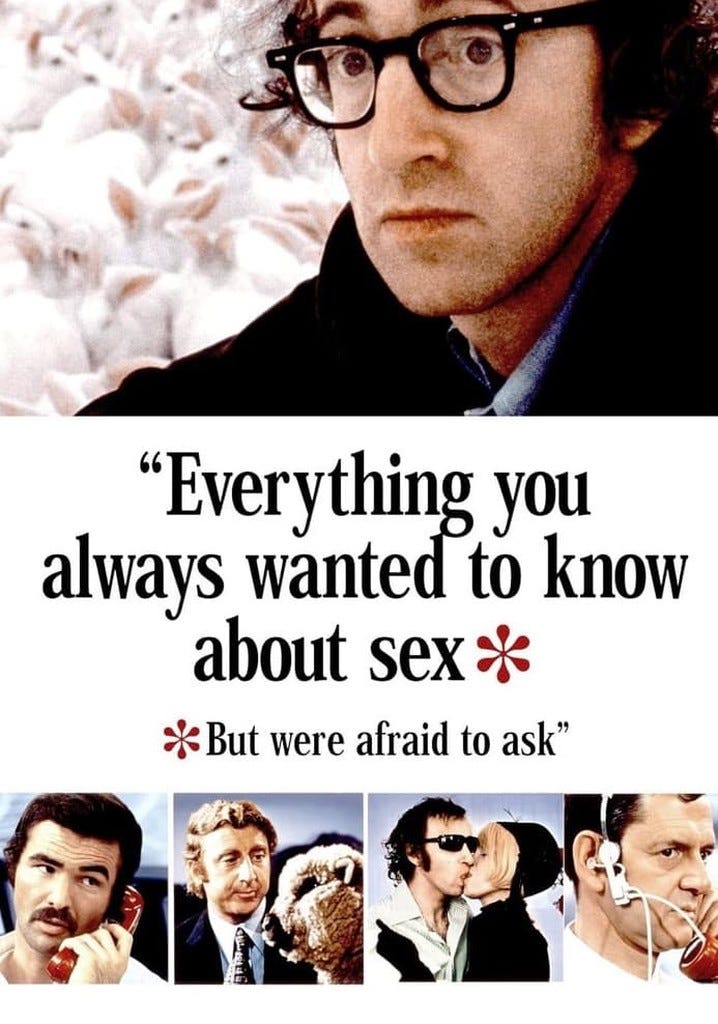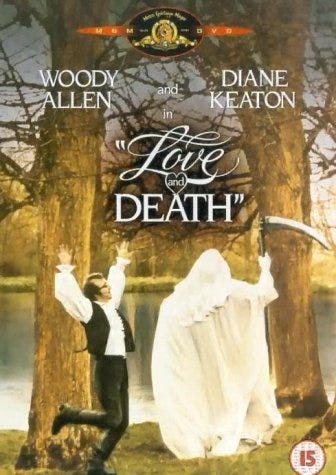I’m diving into Woody Allen’s world —watching all 52 of his movies and jotting down my thoughts on each one. It’s something I’ve always wanted to do, and I thought it would be fun to share it with you. Along the way, I’ll be reading The Ultimate Woody Allen Film Companion and his autobiography, Apropos of Nothing. It’s going to be a fun ride—this is My Woody Allen Summer.
Woody Allen has distinct eras in his long body of work. The first one, encompassing his first six movies, primarily focuses on comedy with relatively similar patterns. To help guide the review, here are some basics to pay attention to:
Drama focuses on the character and their personal feelings.
Comedy focuses on social life, the outer layers, and the obvious behaviours of characters.
In many comedy films, it's clear from the beginning that a particular group of society or institution will be made fun of.
In comedy, we shouldn’t be surprised by the randomness of situations.
In comedy, we laugh at the hero’s repeated failures—what would make us cry in drama. In drama, we expect the character to try hard and maybe succeed, but in comedy, it’s the opposite.
In comedy, the intensity of contrast is funny. Writing a scene where a situation starts in one way and ends in the most unexpected way makes us laugh more.
Use of repetition and reverse repetition
Summary of key points from Hosein Mozaezinia's class
4. Everything You Always Wanted to Know About Sex* (*But Were Afraid to Ask) (1972)
“IN A NUTSHELL: Seven vignettes about sex, each inspired by a question from Dr. Reuben’s bestselling 1969 sex manual.”
I don’t think it would go far to call this the most absurd movie in Allen’s work. It’s so bizarre and, for its time, I would think progressive, with some jokes still able to surprise you 53 years later. If we go back to the basics of comedy, many of them can be found in this movie.
First: Do aphrodisiacs work?
The first episode, where Allen plays the Fool in a Shakespearean-era setting, is the most entertaining for me. It feels a lot like watching stand-up comedy, and what makes it so funny is that, as a typical Fool, he keeps telling hilarious jokes, but the room remains dead silent. You wouldn’t expect to see a Fool bombing in front of an audience.
Second: What is sodomy?
An Armenian shepherd reaches out to a well-known and respected doctor, believing that Daisy has fallen out of love with him. It turns out Daisy is a sheep, which Dr. Ross himself ends up falling in love with. Do I need to say more?
Third: Why do some women have trouble reaching an orgasm?
In this Italian-language homage to directors Antonioni and Fellini, Gina (Louise Lasser) can only achieve orgasm in public places. Her husband, Fabrizio (Woody Allen), discovers that the thrill of being caught excites her, leading to increasingly daring public encounters. The segment satirizes European art films with its stylized approach.
Fourth: Are transvestites homosexuals?
Sam (Lou Jacobi), a middle-aged man, enjoys dressing in women’s clothing. His secret is exposed during a family dinner when he is caught in the act. Again, this movie was made in the 70s, and the theme is still hilarious.
Fifth: What are sex perverts?
A parody of the TV game show What’s My Line?, this segment features a panel guessing a contestant’s perversion. This one is so funny I couldn’t believe what I was watching. From the contestants to the panel, to the questions and the winner of the competition, it’s masterfully executed.
Sixth: Are the findings of doctors and clinics who do sexual research and experiments accurate?
Victor (Woody Allen) and journalist Helen (Heather MacRae) visit Dr. Bernardo (John Carradine), a mad scientist conducting bizarre sexual experiments. This is the only segment I would say didn’t come out as funny as they probably intended, but it’s by far the most bizarre. Victor ends up being chased through town by a huge boob shooting milk as bullets, and is finally contained by a gigantic bra.
Seventh: What happens during ejaculation?
A comedic depiction of the internal processes during male ejaculation, portrayed as a NASA-like mission control center. This one is filled with so many rhythmic, on-the-spot jokes that you can miss even 10 seconds of it. The first and last segments are my favourites on this crazy ride.
“Before you know it, the Renaissance will be here and we’ll all be painting.”
—The Fool”
5. Sleeper (1973)
“IN A NUTSHELL: Health food store owner Miles Monroe goes into the hospital in 1973 for a minor procedure—and wakes up 200 years in the future.”
“In the fall of 1972, Woody Allen bid farewell to standup comedy. He worked up no new material for his six-week, six-city standup tour (culminating in Las Vegas); he did the old act, to the delight of audiences across the country. And then he retired it—and himself.”
The Ultimate Woody Allen Film Companion
Jason Bailey
This marks the first collaboration between Diane Keaton and Allen as director, after they worked together on Play It Again, Sam, where Allen wrote and played the role of Allan Felix, a newly divorced film critic attempting to return to the dating world with the help of his best friends and the ghost of Humphrey Bogart.
”Sleeper was advertised as “a nostalgic look at the future.” The tagline was apt; in spite of the visionary setting, this was Allen’s most retro film to date, with its dystopian-future storyline serving as a framework for a direct homage to silent comedy.
If the physical chaos of those sequences recalls Chaplin, his facial expressiveness (and dark glasses) echo Harold Lloyd, while the mechanics of the gags are straight out of Buster Keaton.”
The Ultimate Woody Allen Film Companion
Jason Bailey
Luna in Sleeper was a role written specifically for Keaton, keeping her unique gifts and comic timing in mind, and it shows. She is brilliant, and my favourite scene is when she impersonates a mix of a Godfather-like Brando-Pacino monologue.
5. Love and Death (1975)
“IN A NUTSHELL: In this parody of Russian literature, cowardly Boris Grushenko falls in love with his cousin, who convinces him to join her in a plot to assassinate Napoleon.”
I watched this movie many years ago, back when I didn’t know much about Russian literature or European cinema. Naturally, I almost missed all the homages Allen had woven into every nook and cranny of the film. But I still managed to enjoy it, with all the absurdity of its characters and out-of-place philosophical dialogues. This time around, I was older, a tad wiser, and knew a thing or two about Russian literature and who Ingmar Bergman is, and it felt like watching a whole new movie.
One of my favourite scenes out of many was when Boris is challenged to a duel:
The Duelist: (slaps Boris across the face with a glove)
Boris: "What is that? What is that? What are you doing?"
The Duelist: "I challenge you to a duel, sir!"
Boris: "A duel? You slap me with a glove, and you call that a duel?"
The Duelist: "Yes, I do!"
Boris: "Well, why don’t you just hand me a sword and get it over with?"
“With each passing film, Allen adds a new and vital element to his toolbox: visual style (Everything You Always Wanted to Know About Sex), semi-serious romance (Play It Again, Sam), attentiveness to narrative (Sleeper), and a pronounced art film influence (Love and Death). With all those qualities at his fingertips, he was now ready to make his most sophisticated picture to date: Annie Hall”
The Ultimate Woody Allen Film Companion
Jason Bailey







